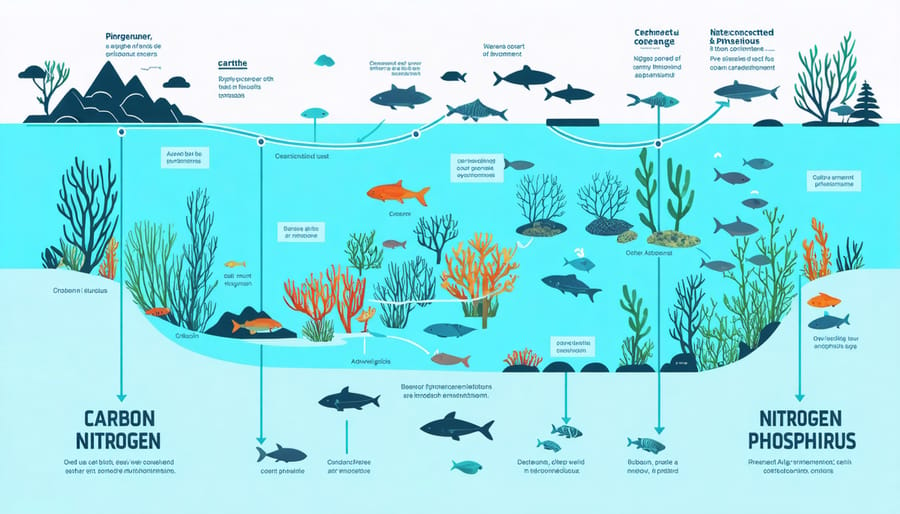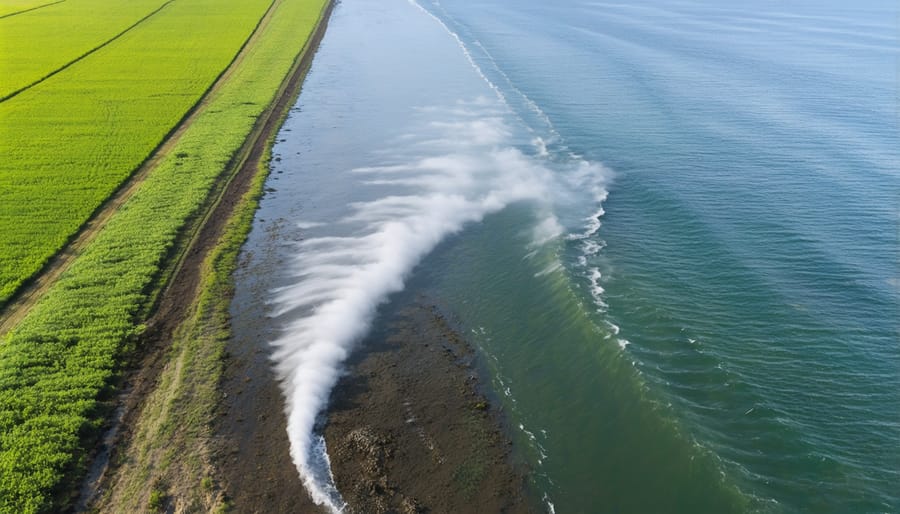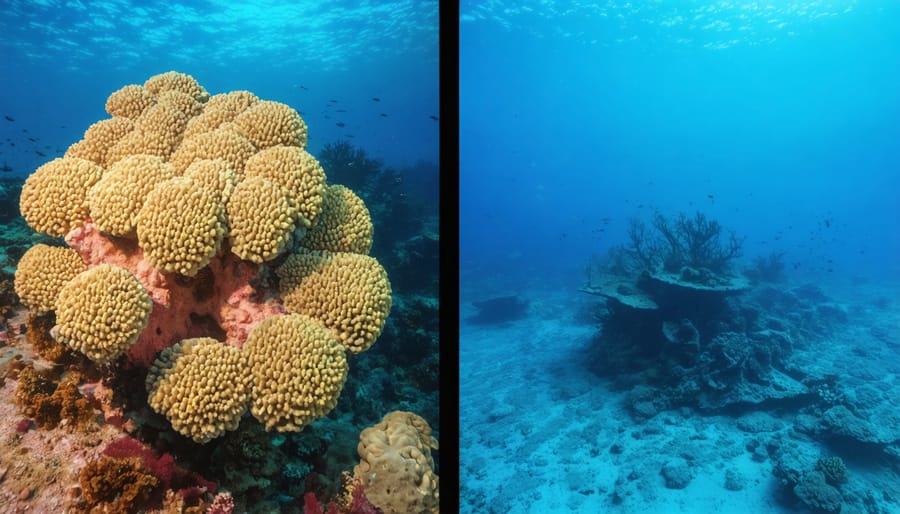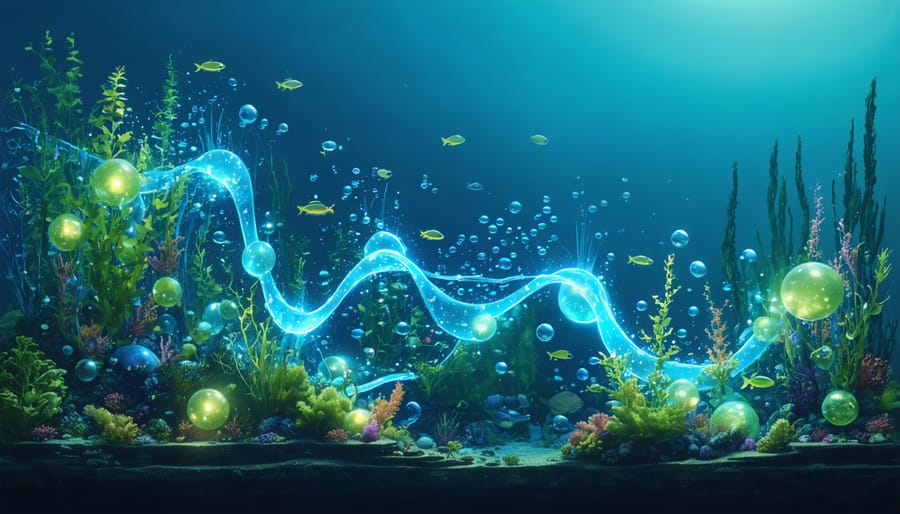Beneath the ocean’s surface lies a complex chemical dance that powers life itself, where microscopic organisms orchestrate the transformation of essential elements like carbon, nitrogen, and phosphorus. The interplay between marine life and seawater chemistry – known as ocean biogeochemistry – fundamentally shapes Earth’s climate, marine ecosystems, and even atmospheric composition. As bioenergy production and human activities increasingly influence these delicate cycles, understanding ocean biogeochemistry has become crucial for preserving our marine environments.
From Australia’s Great Barrier Reef to the deep Antarctic waters, these chemical processes sustain marine food webs, regulate global temperature, and help absorb nearly one-third of human-generated carbon dioxide. The ocean’s remarkable capacity to process and recycle nutrients through biological and chemical pathways makes it Earth’s largest active carbon sink and most dynamic chemical laboratory.
Yet this natural system faces unprecedented challenges. Rising ocean temperatures, acidification, and changing circulation patterns are disrupting these vital processes, threatening marine ecosystems and the services they provide to human societies. By understanding these complex interactions, we can better protect our oceans and develop solutions that work in harmony with these essential natural cycles.
This intricate biochemical network represents more than just scientific curiosity – it’s the foundation of ocean health and, by extension, our planet’s future. Through innovative research and conservation efforts, particularly in Australian waters, we’re discovering new ways to work with these natural processes rather than against them.
The Delicate Balance of Ocean Chemistry
Carbon, Nitrogen, and Phosphorus Cycles
The ocean’s biogeochemical cycles are nature’s remarkable recycling systems, continuously moving essential nutrients through marine environments. In our coastal waters, from the Great Barrier Reef to the Southern Ocean, these cycles maintain the delicate balance that supports marine life.
The carbon cycle serves as the ocean’s climate regulator, with surface waters absorbing about 30% of atmospheric CO2. This process, while helping mitigate climate change, also leads to ocean acidification, affecting our coral reefs and marine organisms. However, innovative research in the Great Southern waters shows promising natural carbon sequestration methods through seaweed forests.
The nitrogen cycle, crucial for marine productivity, transforms nitrogen into forms that organisms can use. In Australian waters, nitrogen-fixing bacteria and phytoplankton work together, creating a natural fertilization system that supports the entire marine food web. Meanwhile, the phosphorus cycle, often called the ocean’s “biological pump,” moves essential nutrients from surface waters to deeper layers, supporting diverse marine ecosystems.
These interconnected cycles face challenges from human activities, but collaborative efforts between scientists and coastal communities are helping protect these vital processes through sustainable practices and innovative solutions.

Natural vs. Human-Influenced Cycles
The ocean’s natural biogeochemical cycles have evolved over millions of years, creating a delicate balance of nutrient exchange, carbon sequestration, and chemical processes that support marine life. These natural cycles operate through seasonal changes, ocean currents, and biological activities of marine organisms. However, modern industrial activities and human impacts on marine ecosystems have begun to alter these ancient rhythms.
While natural variations in ocean chemistry occur through volcanic activity, weathering of rocks, and biological processes, human-induced changes are happening at an unprecedented rate. The good news is that we’re becoming increasingly skilled at distinguishing between natural and anthropogenic influences, allowing us to develop more targeted solutions. Here in Australia, our research institutions are leading the way in understanding these distinctions, particularly in the Great Barrier Reef region.
By recognizing the difference between natural cycles and human-influenced changes, we can better protect our ocean’s chemical balance while supporting sustainable industrial practices. This understanding is crucial for developing effective marine conservation strategies that work in harmony with natural oceanic processes.
Bioenergy’s Footprint on Coastal Waters
Nutrient Runoff from Biomass Crops
As Australia expands its bioenergy sector, the impact of nutrient runoff from biomass crops on our coastal waters has become an important consideration. When farmers cultivate energy crops like sugarcane and switchgrass, fertilizers and organic matter can make their way into waterways during heavy rains and irrigation, eventually reaching the ocean.
These nutrient-rich runoffs, particularly nitrogen and phosphorus, can trigger significant changes in coastal ecosystems. In Queensland’s Great Barrier Reef region, for instance, agricultural runoff has been shown to stimulate excessive algal growth, potentially disrupting the delicate balance of marine life.
However, innovative farming practices are helping to minimize these impacts. Many Australian farmers are now implementing precision agriculture techniques, using targeted fertilizer application and maintaining buffer zones between crops and waterways. The success story of the Burdekin region showcases how smart irrigation management has reduced nutrient loads reaching the reef by 25% over five years.
Emerging solutions include the use of cover crops and riparian vegetation strips that act as natural filters, catching excess nutrients before they reach waterways. Some forward-thinking farms are also experimenting with closed-loop systems, where runoff is captured and recycled back into irrigation networks.
By combining traditional knowledge with modern agricultural technology, we’re finding ways to produce renewable energy while protecting our precious marine environments. The key is striking the right balance between clean energy production and ocean health.

Processing Plant Effects
Bioenergy processing facilities along coastlines are introducing new dynamics into ocean biogeochemistry through their operational outputs. These facilities, while contributing to renewable energy solutions, create distinct chemical signatures in nearby marine environments. In Australia, where coastal processing plants are becoming more common, researchers have observed measurable changes in water chemistry within adjacent marine ecosystems.
The primary effects stem from cooling water discharge and process-related emissions. When processing plants release treated water, it often carries trace amounts of minerals and altered pH levels. These changes, though typically localized, can influence marine life and chemical cycles in the immediate vicinity. For instance, facilities in Queensland have demonstrated that careful management of discharge temperatures and chemical composition can minimize impact on local reef systems.
Modern processing plants are incorporating innovative solutions to address these challenges. Some facilities now use closed-loop cooling systems that significantly reduce chemical discharge, while others employ advanced filtration technologies to ensure that released water closely matches natural ocean chemistry. The Port of Newcastle’s bioenergy facility showcases how careful environmental monitoring and adaptive management can protect marine ecosystems while maintaining operational efficiency.
Success stories from Western Australia demonstrate that with proper design and management, processing plants can operate with minimal impact on ocean chemistry. These facilities have become models for sustainable industrial development, proving that renewable energy production and ocean health can coexist harmoniously.
Solutions for Sustainable Bioenergy Production
Buffer Zone Management
Buffer zones play a crucial role in maintaining the delicate environmental balance between agricultural lands and coastal waters. In Australia, successful implementations of buffer zone strategies have shown remarkable results in protecting marine ecosystems from harmful agricultural runoff.
These protective zones typically consist of strategically planted vegetation strips, wetlands, and riparian areas that act as natural filters. Native Australian plants like tea trees, bottlebrush, and various sedges have proven particularly effective in trapping sediments and absorbing excess nutrients before they reach coastal waters.
Multiple Australian coastal communities have adopted innovative approaches to buffer zone management. For instance, the Great Barrier Reef catchment area has implemented award-winning buffer systems that combine traditional Indigenous land management practices with modern scientific methods. These systems have reduced nitrogen runoff by up to 60% in some areas while providing additional benefits such as wildlife habitat and carbon sequestration.
Key management strategies include:
– Maintaining vegetation diversity
– Regular monitoring of water quality
– Engaging local communities in buffer zone maintenance
– Implementing seasonal management plans
– Creating wildlife corridors that connect inland and coastal ecosystems
The success of these buffer zones demonstrates how thoughtful land management can protect our precious marine environments while supporting sustainable agriculture. Many coastal farms have reported improved soil quality and reduced erosion as additional benefits of these protective measures.
Advanced Processing Technologies
Recent advancements in ocean biogeochemistry processing have revolutionized how we monitor and protect marine environments. Australian researchers have developed breakthrough technologies that significantly reduce the chemical footprint of oceanographic studies while delivering more accurate results.
One notable innovation is the development of passive sampling devices, which collect data on chemical concentrations without disturbing marine ecosystems. These sophisticated tools use selective membranes that naturally accumulate target compounds over time, eliminating the need for frequent water sampling and chemical preservation.
Smart sensor networks now provide real-time monitoring of ocean chemistry with minimal environmental impact. These autonomous systems, successfully deployed along the Great Barrier Reef, use advanced optical and electrochemical methods to measure parameters like pH, dissolved oxygen, and nutrient levels without introducing additional chemicals into the water.
Biotechnology has also played a crucial role in developing eco-friendly processing methods. Scientists have engineered naturally occurring marine bacteria to act as biosensors, detecting pollutants and chemical changes while leaving no harmful residues. This approach has proven particularly effective in monitoring coastal water quality around major Australian ports.
The integration of artificial intelligence with these technologies has further enhanced their efficiency. Machine learning algorithms now help predict chemical distributions and interactions in marine environments, reducing the need for extensive chemical testing and allowing for more targeted, less invasive sampling strategies. These innovations represent a significant step toward more sustainable ocean research practices.
Australian Success Stories
Great Barrier Reef Protection Initiatives
Australia’s flagship coastal ecosystem management success story can be found in the Great Barrier Reef’s protection initiatives. Through collaborative efforts between government agencies, indigenous communities, and local stakeholders, several groundbreaking programs have shown remarkable results in preserving ocean chemistry and marine life.
The Reef 2050 Water Quality Improvement Plan has significantly reduced agricultural runoff through innovative farming practices. Farmers along the Queensland coast have embraced precision agriculture techniques, resulting in a 25% decrease in nitrogen runoff over the past decade. This improvement directly benefits the reef’s delicate chemical balance and supports healthier coral growth.
Crown-of-thorns starfish control programs demonstrate how targeted interventions can protect reef ecosystems. By managing these predatory species while maintaining natural biodiversity, reef managers have successfully preserved coral communities that play crucial roles in carbon sequestration and nutrient cycling.
The Traditional Owner Reef Protection program showcases how indigenous knowledge can enhance modern conservation efforts. Local communities contribute to water quality monitoring and sustainable fishing practices, combining centuries-old wisdom with contemporary science to maintain healthy ocean chemistry.
These initiatives prove that well-designed protection programs can effectively preserve marine ecosystems while supporting local communities and industries. The Great Barrier Reef’s success stories provide valuable lessons for coastal regions worldwide facing similar challenges in ocean biogeochemistry management.

Innovation in Coastal Bioenergy
Along Australia’s vast coastline, innovative approaches to coastal bioenergy are revolutionizing how we harness marine resources for sustainable power. The Commonwealth Scientific and Industrial Research Organisation (CSIRO) has pioneered groundbreaking research in algal biofuel production, utilizing the nation’s abundant sunlight and coastal waters to cultivate high-yield strains of microalgae.
In Queensland, the Coastal Bioenergy Initiative has successfully developed floating algae farms that not only produce renewable energy but also help filter excess nutrients from coastal waters, creating a win-win solution for energy production and marine ecosystem health. These systems have shown promising results, producing up to 30% more biomass than traditional land-based operations while requiring significantly less freshwater.
Western Australian researchers have made remarkable progress in seaweed farming technology, developing automated harvesting systems that minimize environmental impact while maximizing yield. These innovative farms act as carbon sinks, absorbing CO2 from the atmosphere while providing sustainable biomass for energy production.
The Port of Newcastle has implemented a pilot program combining tidal energy capture with algal biofuel production, demonstrating how multiple renewable technologies can work in harmony. This integrated approach has reduced the port’s carbon footprint by 15% while creating local green jobs.
These achievements showcase Australia’s leadership in marine bioenergy innovation, setting new standards for sustainable coastal energy production worldwide.
Ocean biogeochemistry stands at the forefront of understanding our marine ecosystems and their role in global climate regulation. As we’ve explored throughout this article, the intricate chemical dance between marine life, seawater, and the atmosphere continues to shape our planet’s future. The complex interactions between biological processes and chemical cycles in our oceans present both challenges and opportunities for environmental management.
Looking ahead, emerging technologies and research methods are opening new windows into understanding these vital processes. Australian scientists are leading the way in developing innovative monitoring systems and predictive models that help us better understand and protect our marine environments. These advances are particularly crucial for the Great Barrier Reef and other unique marine ecosystems that call our waters home.
The future of ocean biogeochemistry research holds promising developments. Machine learning and artificial intelligence are revolutionizing our ability to process vast amounts of oceanographic data, while new sensor technologies enable real-time monitoring of chemical changes in marine environments. These tools will be essential as we work to address challenges like ocean acidification and changing nutrient cycles.
For Australia, maintaining healthy ocean chemistry is not just an environmental imperative but an economic necessity. Our marine industries, from fishing to tourism, depend on balanced ocean ecosystems. By continuing to invest in research and implementing science-based management strategies, we can work towards ensuring the long-term health of our oceans.
The path forward requires collaboration between scientists, industry leaders, and policymakers, along with continued public engagement and support. Together, we can build on our understanding of ocean biogeochemistry to create more effective conservation strategies and ensure a sustainable future for our marine environments.

